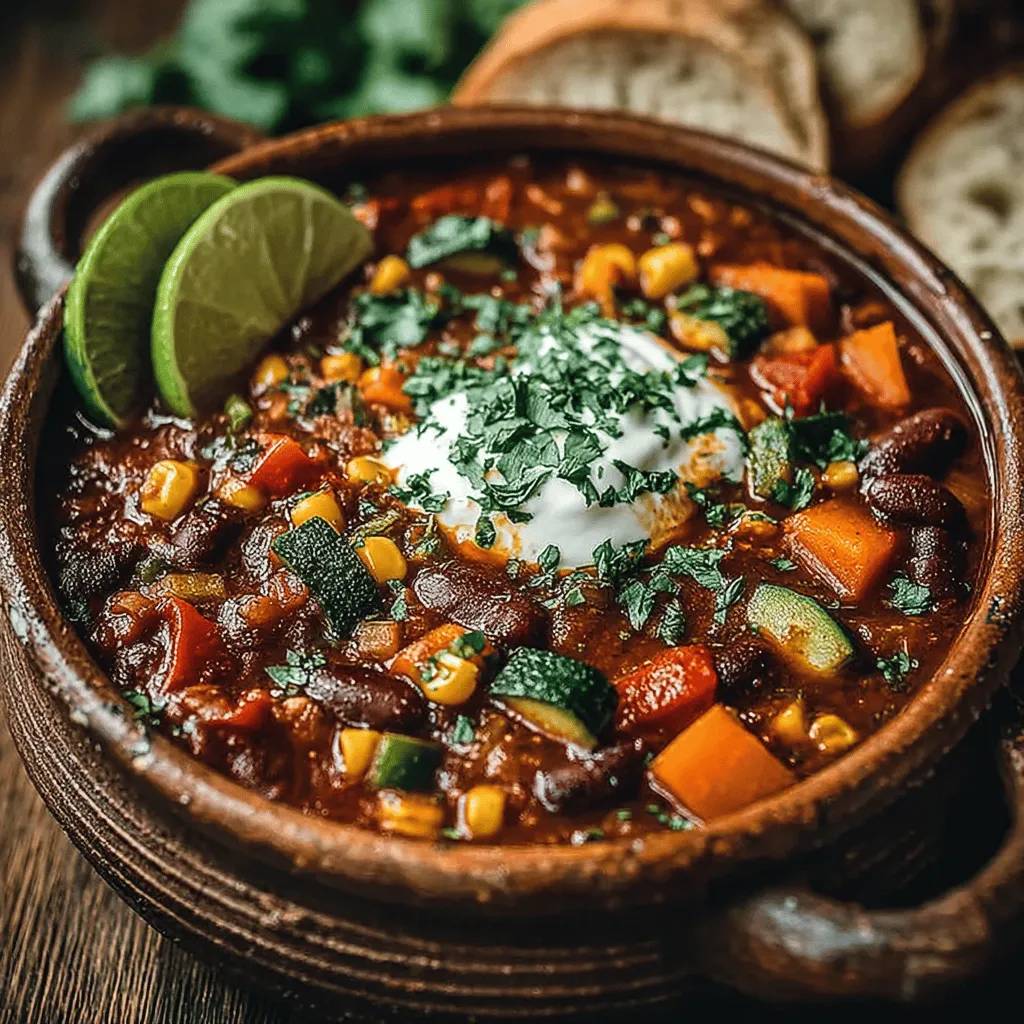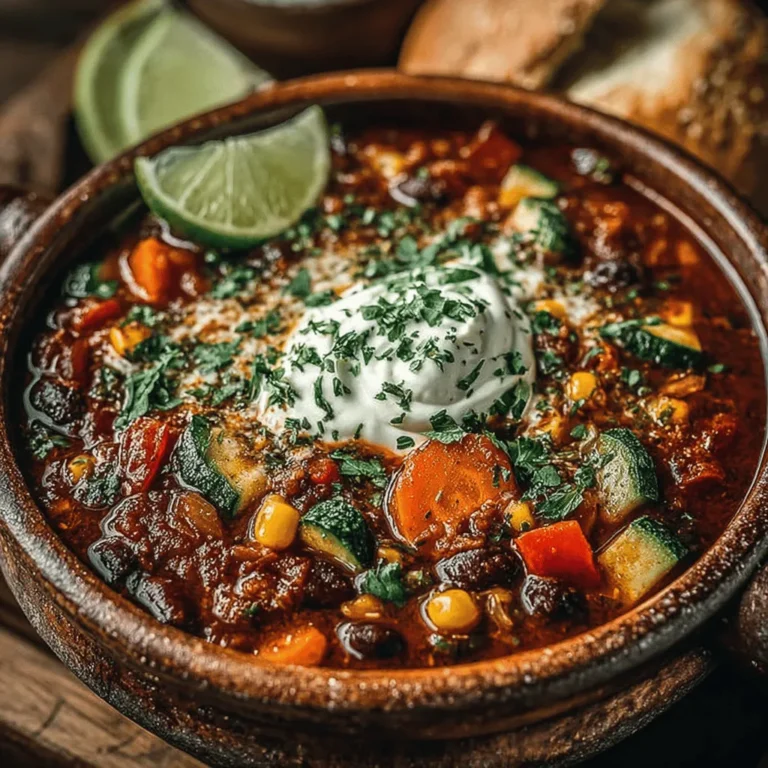Introduction
Chili is a beloved dish that warms the soul, especially during the colder months. Its rich, hearty nature makes it a staple in many households, often serving as a comfort food that brings families together around the dinner table. Among the myriad of chili recipes available, “Chili Bliss: Hearty Vegetable and Bean Chili” stands out as a nutritious and flavorful option that caters to both vegetarians and meat-lovers alike. This recipe is not only packed with flavor but also loaded with nutrients from an array of fresh vegetables and protein-rich beans. Whether you’re a seasoned vegetarian or simply looking to incorporate more plant-based meals into your diet, this chili is a perfect choice.
In this article, we will delve into the ingredients, preparation steps, and the health benefits of this hearty dish, making it suitable for any occasion, from a cozy family dinner to a gathering with friends.
The Nutritional Powerhouse of Chili
Overview of Key Ingredients
One of the standout features of “Chili Bliss” is its impressive array of vegetables. Each ingredient not only contributes its unique flavor but also brings a wealth of nutritional benefits to the table.
– Onions: These aromatic vegetables are a staple in many cuisines and serve as the foundation for this chili. Rich in antioxidants, onions help reduce inflammation and support heart health.
– Bell Peppers: Available in various colors, bell peppers are high in vitamins A and C and add a sweet crunch to the dish. Their vibrant hues also indicate the presence of beneficial phytochemicals.
– Carrots: These root vegetables are not only sweet and crunchy but also packed with beta-carotene, which is converted into vitamin A in the body. Carrots contribute to eye health and provide a subtle sweetness that balances the spices in the chili.
– Zucchini: This versatile vegetable adds bulk to the chili without many calories. Zucchini is high in water content, making it hydrating, and it also provides essential vitamins and minerals.
The beans used in this recipe are equally impressive.
– Black Beans: Known for their high protein and fiber content, black beans are a fantastic addition to any plant-based dish. They help to promote satiety and keep you feeling full longer.
– Kidney Beans: These beans are not just visually appealing with their deep red color; they are also rich in iron and potassium, making them excellent for muscle function and overall health.
The spices play a crucial role in elevating the flavor profile of this chili.
– Chili Powder: This blend of spices adds heat and complexity to the dish. It often includes a mix of ground chili peppers, cumin, garlic powder, and sometimes even herbs.
– Cumin: Known for its warm, earthy flavor, cumin enhances the overall taste of the chili while offering digestive benefits.
– Smoked Paprika: This spice brings a distinct smoky flavor that can transform an ordinary chili into a gourmet dish. It also contains antioxidants that support the immune system.
Health Benefits of a Plant-Based Diet
Incorporating a dish like “Chili Bliss” into your meal rotation comes with numerous health benefits associated with a plant-based diet.
– Weight Management: A diet rich in vegetables and legumes can aid in weight control due to their low calorie density and high fiber content. High-fiber foods help you feel full, reducing the likelihood of overeating.
– Heart Health: The combination of beans and vegetables in this chili supports cardiovascular health. The fiber in beans can help lower cholesterol levels, while the antioxidants in vegetables combat oxidative stress.
– Digestive Health: The fiber-rich ingredients in chili promote digestive wellness by supporting regular bowel movements and fostering a healthy gut environment. This can lead to improved overall health and well-being.
Gathering Ingredients for Chili Bliss
Essential Ingredients Breakdown
Before diving into the preparation of “Chili Bliss,” it’s essential to gather all the ingredients required for this flavorful dish.
– Fresh Vegetables: When selecting vegetables, aim for organic and locally sourced options whenever possible. Fresh produce not only tastes better but also retains more nutrients. Look for firm, brightly colored vegetables to ensure maximum flavor and nutritional value.
– Canned Goods: Canned beans and tomatoes are convenient staples for any pantry. When choosing canned goods, opt for low-sodium varieties to keep your chili healthy. Rinsing canned beans can also help reduce sodium content while improving flavor.
– Spices and Seasonings: Fresh, high-quality spices can significantly enhance the flavor of your chili. Consider purchasing whole spices and grinding them yourself for a fresher taste. Store spices in a cool, dark place to maintain their potency.
Optional Ingredients for Personalization
One of the joys of making chili is the ability to customize it according to personal preferences. Feel free to experiment with various ingredients to make the dish your own.
– Different Types of Beans: While black beans and kidney beans are the stars of this recipe, you could also incorporate pinto beans, white beans, or chickpeas for added variety and texture.
– Vegetable Variations: If you have favorite vegetables, such as corn, sweet potatoes, or spinach, feel free to toss them in. Just be mindful of cooking times to ensure everything is perfectly tender.
– Spice Adjustments: If you prefer a milder flavor, reduce the amount of chili powder or opt for sweet paprika instead of smoked. Conversely, if you crave more heat, consider adding diced jalapeños or a pinch of cayenne pepper.
Step-by-Step Preparation of Hearty Vegetable and Bean Chili
Preparation Phase
Before you start cooking, it’s crucial to prep your workspace. A well-organized kitchen can make the cooking process smoother and more enjoyable.
1. Gather All Ingredients: Lay out all your ingredients on a clean countertop. This will help you visualize the quantities and types of ingredients you’ll be working with.
2. Chop and Measure: Begin by washing and chopping all the fresh vegetables. This includes dicing the onions, bell peppers, and carrots, and slicing the zucchini. Measure out the spices and set them aside to streamline the cooking process.
3. Set Up Your Cooking Equipment: Ensure you have all necessary cooking tools on hand, such as a large pot or Dutch oven for the chili, a cutting board, and a sharp knife.
By following these initial steps, you’ll set yourself up for a successful cooking experience, paving the way for a delicious bowl of “Chili Bliss.” As you move forward with the recipe, the comforting aroma of simmering vegetables and spices will fill your kitchen, promising a delightful meal ahead.

Chopping Vegetables
Efficient vegetable chopping is essential for saving time in the kitchen, especially when preparing a hearty dish like Chili Bliss. To chop vegetables quickly and safely, start by gathering your tools: a sharp chef’s knife, a cutting board, and a vegetable peeler. Here are some techniques to streamline your chopping process:
1. Prep Your Workspace: Clear your cutting board of any clutter. Having a clean area will make it easier to move around and chop efficiently.
2. Use the Claw Grip: When holding your vegetable, use the claw grip with your fingers curled under to protect your fingertips. This method also helps you maintain control over the knife and the vegetable.
3. Slice in Batches: For items like bell peppers or zucchini, slice them into manageable pieces first, then chop those pieces into your desired size. This technique saves time by allowing you to make multiple cuts at once.
4. Seasonal Preparation: Incorporate seasonal vegetables to enhance flavor and nutrition. For instance, substituting summer squash in the summer or using root vegetables in the winter can elevate your dish.
With all your vegetables chopped and ready, you’re set to create a flavorful base for your chili.
Cooking Process
Sautéing the Base
Creating a flavorful base is the cornerstone of any great chili. Begin by heating a large pot or Dutch oven over medium heat. Add a splash of olive oil, about 2 tablespoons, and allow it to heat until shimmering.
1. Sauté Onions: Add 1 medium diced onion and sauté for about 5-7 minutes until translucent. Stir occasionally to prevent burning. The onions will release their natural sweetness and form the foundation of your chili.
2. Add Garlic: Once the onions are softened, add 3-4 minced garlic cloves and sauté for an additional minute. Be careful not to let the garlic burn, as it can turn bitter.
This combination of sautéed onions and garlic creates a fragrant aroma that signals the start of something delicious.
Building Flavor with Vegetables
Next, it’s time to build upon your flavorful base by adding the rest of your vegetables. You want to introduce the vegetables in stages to create layers of flavor and ensure that each ingredient retains its texture.
1. Add Hard Vegetables First: Start with sturdy vegetables like bell peppers (1-2, diced) and carrots (2, diced). Sauté these for about 5 minutes until they begin to soften.
2. Incorporate Softer Vegetables: Follow with softer vegetables such as diced zucchini (1 large) and corn (1 cup). Sauté these for an additional 3-4 minutes.
By cooking the vegetables in stages, you allow each one to reach its optimal texture and flavor, preventing any from turning mushy.
Incorporating Beans and Broth
Combining Ingredients
Once the vegetables are sautéed, it’s time to incorporate the beans and broth. Stir in your choice of beans—about 2 cans (15 oz each) of rinsed and drained beans such as black beans and kidney beans. This not only adds protein but also enhances the heartiness of your chili.
1. Add Broth and Tomatoes: Pour in 4 cups of vegetable broth and add 1 can (14.5 oz) of diced tomatoes with their juice. Stir everything well to combine, ensuring an even distribution of flavors throughout the mixture.
2. Seasoning: At this point, add your seasonings—1 tablespoon of chili powder, 1 teaspoon of cumin, and salt and pepper to taste. Stir well to infuse the spices throughout the chili.
Simmering for Perfection
The Art of Simmering
Simmering is the final step that allows all the flavors to meld beautifully. Bring the chili to a gentle boil over medium-high heat. Once boiling, reduce the heat to low, cover, and let it simmer for at least 30 minutes.
1. Check for Thickness: If you prefer a thicker chili, let it simmer uncovered for the last 15 minutes. This will allow the liquid to reduce and the flavors to concentrate.
2. Taste and Adjust: During the last few minutes of simmering, taste your chili and adjust the seasoning as necessary. Add more salt, pepper, or chili powder based on your preference.
The longer you let your chili simmer, the richer the flavors will become, making this an essential step in the cooking process.
Serving Suggestions for Chili Bliss
Ideal Pairings
Chili is not just a dish; it’s a canvas for creativity. Here are some suggestions for toppings and accompaniments that will elevate your Chili Bliss experience:
Toppings
1. Fresh Herbs: Chopped cilantro or green onions can add a refreshing finish to your chili.
2. Sour Cream or Greek Yogurt: A dollop of sour cream or Greek yogurt can provide a creamy contrast to the spicy chili.
3. Cheese: Grated cheese such as cheddar or Monterey Jack adds richness and depth.
Accompaniments
1. Crusty Bread: Serve your chili with a side of crusty bread or cornbread to soak up the flavors.
2. Rice or Quinoa: For a more filling meal, consider serving your chili over cooked rice or quinoa. This adds a nice texture and complements the dish well.
Presentation Tips
How you serve your chili can enhance the overall dining experience. Here are some ideas to make your presentation pop:
1. Use Colorful Bowls: Opt for vibrant bowls that contrast with the deep red of the chili. This will make the dish visually appealing.
2. Layer Toppings: When serving, layer your toppings on the chili rather than mixing them in. This creates a beautiful visual presentation and allows guests to customize their bowls.
Variations on the Classic Chili Recipe
Alternative Ingredients
Chili is incredibly versatile, and there are many ways to adapt this recipe to suit your taste preferences or dietary needs.
Protein Substitutes
If you want to add more protein or change the flavor profile, consider these options:
1. Plant-Based Proteins: Substitute beans with lentils or chickpeas for a different texture and flavor.
2. Quinoa: Adding cooked quinoa not only increases protein content but also adds a nutty flavor.
Flavor Twists
Experiment with spices for a unique take on classic chili:
1. Smoked Paprika: This can add a smoky depth to your dish.
2. Regional Flavors: Try incorporating chipotle peppers for a smoky heat or curry powder for an unexpected twist.
Seasonal Variations
As seasons change, so can your chili. Adjust your ingredients based on what’s fresh and available:
1. Spring: Incorporate fresh peas or asparagus for a lighter version.
2. Fall/Winter: Add root vegetables like sweet potatoes or parsnips for a heartier, warming chili.
Conclusion
Chili Bliss: Hearty Vegetable and Bean Chili is not just a dish; it’s a celebration of wholesome ingredients coming together to create a comforting meal. This recipe nourishes the body and brings joy and warmth to the table. By understanding the nutritional benefits, preparation techniques, and versatile serving options, you can make this chili your own. Embrace this delicious recipe and enjoy the hearty flavors and health benefits it offers, making it a staple in your kitchen for years to come. Whether you serve it as a main course or a side dish, this chili is sure to become a favorite among family and friends alike.


